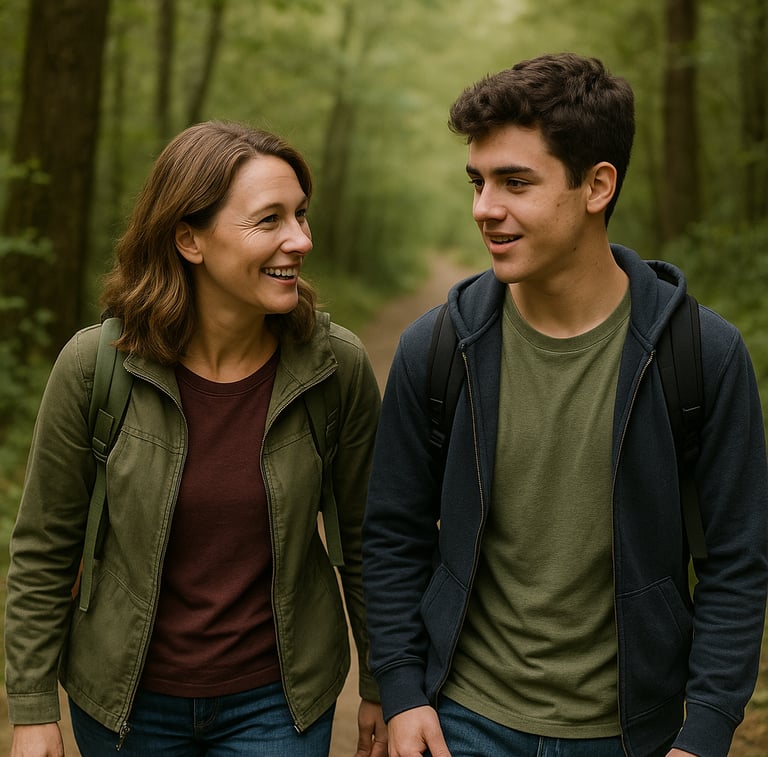Nature Hikes and Talks: Strengthening Family Bonds One Step at a Time
Discover how nature hikes and talks can strengthen parent child bonding, inspire meaningful conversations, and create lasting family memories. Includes parenting tips, mindful parenting strategies, and dialogue prompts.
BONDING ACTIVITIES
Collin Kelly
7/13/20254 min read


In our busy lives, finding simple yet meaningful ways to bond with our children can feel like a challenge. Between homework, work deadlines, and countless responsibilities, it’s easy to let moments of connection slip away. But there’s a timeless activity that combines fresh air, movement, and heartfelt conversations: nature hikes and talks.
Whether you explore a nearby trail, wander through a local park, or adventure in your own neighborhood, walking together in nature creates quality time that your child will cherish for years. Let’s look at how to turn a simple hike into a tradition that strengthens parent‑child bonding and builds unforgettable memories.
Why This Activity Matters for Parent‑Child Bonding
Walking in nature naturally slows the pace of life. The absence of screens, traffic, and household distractions creates a space where you and your child can simply be. You’re side by side, not face to face, which often makes it easier for kids to open up and share their thoughts.
Picture this:
The trail crunches softly beneath your feet as the trees sway above. Your child skips ahead, stops to inspect a pinecone, and then falls in step with you. “Do you think birds talk to each other?” they ask, and suddenly you’re having a conversation you never would’ve had at the dinner table.
This is mindful parenting in its purest form—showing your child that you’re present, listening, and enjoying their company. Nature hikes also teach patience, observation, and gratitude, all while creating treasured family activities.
Parenting tip: Celebrate curiosity. If your child asks about a plant or bird you don’t know, say, “Let’s look it up together later.” It shows them learning is lifelong.
How to Prepare and Minimize Distractions
A little planning makes your hike smoother and more enjoyable for everyone:
Pick the right trail. Choose a kid‑friendly hike with manageable length and interesting features like streams, wildflowers, or lookout points.
Pack lightly. Bring water, snacks, sunscreen, and maybe a small notebook for observations.
Leave devices behind. Keep phones on silent except for emergencies. Let your child see that this time is about connection, not notifications.
Dress appropriately. Wear comfortable shoes, bring jackets or hats as needed, and be prepared for changing weather.
Plan your time. Choose a morning or late afternoon when you’re not rushed and can linger if something catches your child’s attention.
Mindful parenting tip: Let your child help plan. Ask, “Should we bring binoculars or a camera?” Involving them gives them a sense of ownership and excitement.
Step‑by‑Step Ideas to Make the Most of It
Here’s how to turn a simple walk into a meaningful experience:
Start with a theme. Look for animal tracks, collect interesting leaves, or count how many bird songs you can hear.
Walk at their pace. Let them stop, explore, and ask questions. It’s not about miles covered; it’s about connection built.
Share stories. Tell them about your childhood hikes or a funny camping story. Invite them to share their own.
Play observation games. “Who can spot something red first?” or “Let’s find three different kinds of leaves.”
Pause for reflection. Sit on a log or bench and just take in the scenery together. “What do you hear? What do you smell?”
End with gratitude. On the way back, ask what they liked most. “I loved seeing that deer. What was your favorite part?”
These steps create a rhythm of exploration and conversation, making nature hikes and talks one of the most meaningful family activities you can share.
Example Dialogues to Encourage Connection
Here are a few sample conversations to inspire meaningful chats on your hike:
Example 1
Parent: “I love spending this time with you. What part do you enjoy the most?”
Child: “I like when we try new things together!”
Example 2
Parent: “Look at that big tree! What do you think it’s seen in its lifetime?”
Child: “Maybe a thousand squirrels and a hundred birds!”
Example 3
Parent: “If you could make your own trail, where would it go?”
Child: “Through a rainbow forest with magical animals!”
These open‑ended conversations strengthen your bond and spark your child’s imagination.
Prompts to Deepen the Experience
Want to take your hike conversations to the next level? Try these prompts while walking:
“What’s your favorite memory from our hikes so far?”
“If we could camp here tonight, what would we do?”
“How can we make our next hike even more fun?”
“What’s something new you’d like to learn about nature?”
Parenting tip: Keep these prompts light and fun. Let your child lead the conversation and follow their curiosity.
Real‑Life Story to Inspire You
One parent shared:
“I started hiking with my son during weekends because I wanted him to spend less time on screens. At first, he complained about the bugs and the walking. But soon he started pointing out flowers and asking big questions about the stars and trees. Now, it’s our favorite ritual. We talk more on those hikes than we do the whole week at home.”
It’s a reminder that what starts as a simple walk can become a cherished family tradition.
Final Thoughts and Encouragement
Nature hikes and talks are a beautiful way to combine movement, mindfulness, and meaningful conversation. By stepping away from technology and into nature, you’re giving your child a gift: your full presence and the chance to explore the world together.
These hikes don’t have to be long or complicated. Even a stroll through a neighborhood park can spark deep conversations and joyful memories. The important part is walking side by side, slowing down, and savoring the moment.
So lace up those sneakers, pack a snack, and head outside. The path ahead is full of discovery, laughter, and the kind of parent‑child bonding that lasts a lifetime.
